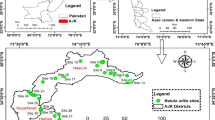Abstract
We conducted a mesoscale transect sampling of trees ≥10 cm DBH in the Lomako–Yekokora interfluvial forest, Democratic Republic of the Congo. Our objective was to characterize the forest landscape contained between the Lomako and Yekokora rivers in terms of its floristic composition and to investigate how representative the Lomako study site, the location of a long-term study of primates, was of the entire forest block. Fifteen transects were laid out at seven sample stations placed approximately 10 km apart and alongside a 70 km trail running from the Lomako study site to the margins of the Yekokora river. Three transects totaling 3.65 ha were laid out at the Lomako study site and two transects totaling 2 ha at each of the remaining six sample stations, amounting to 15.65 ha in total. Average DBH, tree density, tree species richness and floristic composition were determined for each transect. There were 5353 trees ≥10 cm DBH in the total sample, representing 150 species in 35 families. Caesalpinoideae trees dominated the sample followed by Olacaceae and Annonaceae. Four forest types were identified: mixed primary (57% of the sampled plots), secondary forest (9%), Gilbertiodendron (22%), and swamp (12%). The seven sample stations differed from each other in average DBH, tree density, tree species richness and floristic composition. Most of the difference, however, was due to the fact that the four forest types were not equally represented at each sample station. When forest types were contrasted independently, a marked difference in average DBH, tree density, tree species richness and floristic composition was recorded. Conversely, when only mixed primary forest was analyzed across the sample stations, no significant difference was detected except for average DBH. Thus the Lomako study site is representative of the forest landscape contained between the Lomako and Yekokora rivers only when the different forest types are treated separately. The sample stations (including Lomako) differ from each other, however, in the proportional contribution of each forest type.
Similar content being viewed by others
References
Connell J.and Lowman M.D.1989. Low-diversity tropical rain forests:some possible mechanisms for their existence. American Naturalist 134: 88–119.
Dasilva G.L.1994. Diet of Colubus Polykomos on Tiwai Island:selection of food in relation to its seasonal abundance and nutritional quality. International Journal of Primatology 15: 655–678.
Devred R. 1958. La Vegetation Forestiere du Congo Belge et du Ruanda-Urundi. Bulletin de la SociétéRoyale Forestiere de Belgique 65: 409–468.
Fruth B.1995. Nests and nest groups in wild bonobos (Pan paniscus ):ecological and behavioural correlates. In: Biologie, Ludwig-Maximilians-Universität, München, Germany,187 pp.
Gauthier Poulin Thériault and Ltée 1977. Manuel de Dendrologie. ACDICI, Québec, Canada.
Gautier-Hion A., Gautier J.P. and Maisels F.1993. Seed dispersal versus seed predation:an intersite comparison of two related African monkeys.Vegetatio 107/108: 237–244.
Gerard P.1960. Etude Écologique de la Forêt Dense à Gilbertiodendron dewevrei dans la Région de l'Uele. No. 87 Publication de l'Institute National pour l'Étude Agronomique du Congo Belge (INÉAC),Série Scientifique No. 87, 159 pp.
Germain R.and Evrard C.1956. Etude Écologique et Phytosociologique de la Forêtà Brachystegia laurentii.Vol. 67. Publications de l'Institute National pour l'Étude Agronomique du Congo Belge, pp.1–105.
Hart T.B., Hart J.A. and Murphy P.G.1989. Monodominant and species-rich forests of the humid tropics:causes for their co-occurrence. American Naturalist 133(5): 613–633.
Hartshorn G.S. 1980. Neotropical forest dynamics. Biotropica 12: 23–30.
Juo A.S.R. and Wilding L.P.1996. Soils of the lowlands of west and central Africa. Proceedings of the Royal Society of Edinburgh 104B: 5–29.
Kortlandt A.1995. A survey of the geographical range,habitats and conservation of the Pygmy chimpanzee (Pan paniscus );An ecological perspective. Primate Conservation 16: 21–36.
Krebs C.J.1999. Ecological methodology. Benjamin/Cummings, Menlo Park, California.
Lebrun J. and Gilbert G.1954. Une Classi cation Écologique des Forêts du Congo. Publication de l'Institute National pour l'Étude Agronomique du Congo Belge (INÉAC),Série Scientifique, pp.63–89.
Letouzey R.1969. Manuel de Botanique Forestière, Afrique Tropicale. Centre Technique Forestier Tropical, Marne, France.
Letouzey R.1972. Manuel de Botanique Forestière, Afrique Tropicale, Centre Technique Forestier Tropical, Marne, France.
Ludwig J.A. and Reynolds J.F.1988. Statistical Ecology. John Wiley and Sons, New York.
Maisels F.1996. Synthesis of information concerning the Park National D'Odzala,Congo. Projet Ecofac-Composante Congo. Unpublished report.
Maisels F., Gautier-Hion A. and Gautier J.P.1994. Diets of two sympatric colobines in Zaire:more evidence on seed-eating in forests on poor soils. International Journal of Primatology 15: 681–701.
Newbery D.M. and Gartland J.S.1996. A structural analysis of rain forest at Korup and Douala-Edea,Cameroon. Proceedings of the Royal Society of Edinburgh 104B: 177–224.
Newbery D.M., Alexander I.J., Thomas D.W. and Gartlan J.S.1988. Ectomycorrhizal rain-forest legumes and soil-phosphorus in Korup-National-Park,Cameroon. New Phytologist 109: 433–450.
Oates J.F., Whitesides G.H., Davies A.G., Waterman P.G., Green S.M., Dasilva G.L. and Mole S. 1990.Determinants of variation in tropical forest primate biomass: new evidence from west Africa. Ecology 71: 328–343.
Pielou E.C.1974. Population and Community Ecology. Gordon & Breach, New York.
Pitman N.C.A., Terborgh J., Silman M.R.and Nunez P.1999. Tree species distributions in an upper Amazonian forest. Ecology 80: 2651–2661.
Richards P.W.1973. The tropical rainforest. Africa, the ‘Odd man out’. In: Meggers B.J., Ayensu E.S.and Duckworth W.D.(eds). Tropical Forest Ecosystems in Africa and South America: Comparative Review. Smithsonian Institute Press, Washington, DC.
Richards P.W.1996. The Tropical Rain Forest. Cambridge University Press, Cambridge, UK.
Struhsaker T.T.1975. The Red Colobus Monkey. University of Chicago Press, Chicago, Illinois.
Terborgh J.and Andresen E.1998. The composition of Amazonian forests:patterns at local and regional scales. Journal of Tropical Ecology 14: 645–664.
Tutin C.E.G., Ham R.M., White L.J.T. and Harrison M.J.S.1997. The primate community of the Lope Reserve, Gabon:diets, responses to fruit scarcity and effects on biomass.American Journal of Primatology 42: 1–24.
Vivien J.and Faure J.J.1985. Arbres des Forêts Denses d'Afrique Centrale. Agence de Coopération Culturelle et Technique, Paris, France.
White F.1983. The Vegetation of Africa. UNESCO, Paris, France.
Wiese B.1980. Zaire: Landesnatur, Bevolverung, Wirtscha. Wissenschaftliche Buchgesellschaft, Darmstadt, Germany.
Author information
Authors and Affiliations
Rights and permissions
About this article
Cite this article
Philippe Boubli, J., Eriksson, J., Wich, S. et al. Mesoscale transect sampling of trees in the lomako–yekokora interfluvium, democratic republic of the Congo. Biodiversity and Conservation 13, 2399–2417 (2004). https://doi.org/10.1023/B:BIOC.0000048445.27943.81
Issue Date:
DOI: https://doi.org/10.1023/B:BIOC.0000048445.27943.81




